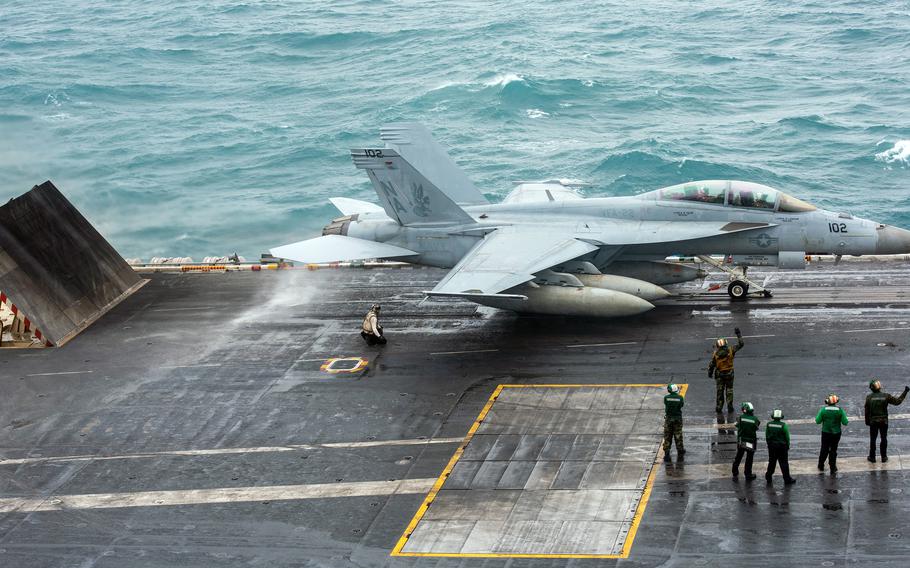
An F/A-18F Super Hornet from Strike Fighter Squadron 22 prepares to launch from the flight deck of the aircraft carrier USS Nimitz, Jan. 19, 2023, while on the South China Sea. (Caylen McCutcheon/U.S. Navy)
The Navy’s fleet of Super Hornet fighter jets introduced in the late 1990s are aging more poorly than the preceding fleet of F-18 Hornets, according to a Congressional Budget Office report released Thursday.
The report compared availability of the newer F/A-18E/F Super Hornets with the older F/A-18C/D Hornets introduced in the mid-1980s and still in use.
Availability refers to the percentage of time an aircraft can be flown for training or operational missions instead of down time for undergoing repair or maintenance.
The CBO’s analysis found the newer Super Hornets had lower availability rates than the F/A-18C/Ds had when compared at similar ages.
“For example, Super Hornet availability at age 10 was about 18 percentage points lower than F/A-18C/D availability at age 10 and is comparable to F/A-18C/D availability at age 20,” the report states.
“These findings suggest that age has had a more adverse effect on Super Hornets than it did on F/A-18C/Ds,” the report states.
The fleet of F/A-18s is the Navy’s “mainstay” of its carrier aviation operations, according to the report. The twin-engine Super Hornets have a top speed of Mach 1.7 and can carry Sidewinder and Harpoon missiles.
The differing rates of availability were not attributable to a greater number of flying hours for the newer jets, which would subject the aircraft to greater wear and tear, the CBO concluded from a review of flight data.
“Monthly flying hours of Super Hornets modestly exceeded those of F/A-18C/Ds only in the initial years of operation of both fleets,” the report states. “By age 10, however, Super Hornets were flying four fewer hours per month than 10-year-old F/A-18C/Ds flew.”
The Navy told the CBO that many factors contributed to differences in availability between the two generations of F-18s, highlighting “the greater levels of galvanic corrosion arising from the greater use of composite metals in Super Hornets,” the report states.
The report’s footnotes describe galvanic corrosion as “damage induced when two dissimilar materials are coupled in a corrosive electrolyte. It occurs when two (or more) dissimilar metals are brought into electrical contact under water.”
The future of availability rates for aging Super Hornets is up in the air, the report states.
“The experiences of the oldest Super Hornets suggest that their availability is likely to continue to decline as the fleet ages,” the report states. “A similar trend has been observed for many fighter and attack aircraft. But some fleets have had lengthy periods with stable availability rates.
“Because the Super Hornet is a relatively new aircraft, the Navy could take actions that might increase or stabilize the aircraft’s availability rate, such as increasing funding for maintenance.”
The Defense Department announced in December that it had awarded Boeing $2 billion to upgrade and modernize software and hardware on the Navy’s fleet of Super Hornets over a five-year period.
Diminishing availability is not just an issue for Navy aircraft.
A January 2022 CBO report found that availability rates for all aircraft in use by the Air Force and the Department of the Navy, which includes the Marine Corps, had declined between 2001 and 2019.
But the decline of availability for Navy aircraft was greater, driven by a “marked decline in the availability of F/A-18C/D legacy Hornets,” the 2022 report stated.